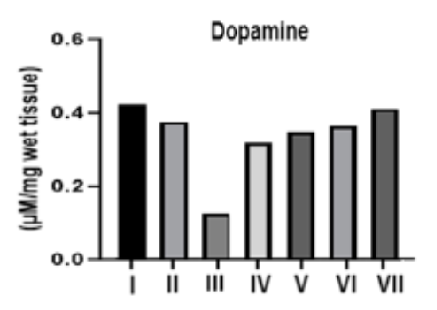


Indian Journal of Science and Technology
DOI: 10.17485/IJST/v16i31.1568
Year: 2023, Volume: 16, Issue: 31, Pages: 2409-2418
Original Article
P Devi Guna Sireesha1, M Vidyavathi1*
1Institute of Pharmaceutical Technology, Sri Padmavati Mahila Visvavidyalayam, Tirupati, Chittoor, 517502, Andhra Pradesh, India
*Corresponding Author
Email: [email protected]
Received Date:23 June 2023, Accepted Date:27 July 2023, Published Date:16 August 2023
Objectives: To study the antioxidant capacity of Murraya koeingii essential oil (MKEO) phytoconstituents Methods: It was determined by using GCMS. The phytoconstituents were then exposed to molecular docking studies that targeted dopamine D2 to look for neuroprotective effects. The highest percentage content of constituents were selected as ligands and dopamine(6VMS) was retrieved from the protein data bank, the docking was performed using Schrodinger software version 2021-4. The pharmacokinetic profile associated with the selected components were predicted utilizing ADMET lab 2.0 and pkCSM which is a graph-based small molecular pk predictor along with toxicity properties of constituents. The neuroprotective activity of MKEO is also predicted by Ex vivo protocol using rotenone as an inducing agent in mice brain slices. Findings: The antioxidant potentials were nearer to the positive control (Ascorbic acid) which proved the antioxidant capacity of MKEO. The antioxidant enzymes of CAT and GSH were also decreased in the mice brain slices which are treated with rotenone and LPO values were decreased. The levels of dopamine, CAT, and GSH were improved in the groups supplemented with MKEO at different concentrations, along with reduced LPO levels. Novelty: These results are reassuring that both In silico and Ex vivo investigations had greater neuroprotective and antioxidant activities for the phytoconstituents examined from MKEO.
Keywords: Murraya koeingii; Neuroprotective; Antioxidant; Toxicity; Parkinson’s Disease
© 2023 Sireesha & Vidyavathi. This is an open-access article distributed under the terms of the Creative Commons Attribution License, which permits unrestricted use, distribution, and reproduction in any medium, provided the original author and source are credited. Published By Indian Society for Education and Environment (iSee)
Subscribe now for latest articles and news.